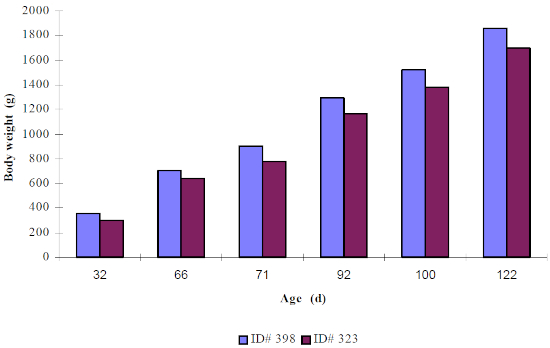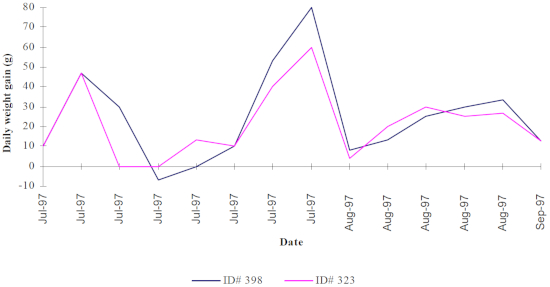Abstract
Growth rates of two infant hand-reared black and white ruffed lemurs (Varecia variegata variegata) were measured from 32 days until 5 months of age. The diet consisted of pureed pumpkin, banana, grape juice, and high-fiber primate biscuits. Body weights steadily increased throughout the whole feeding period. The overall average daily gain for each lemur, from days 32–122, was 23.9 g and 21.3 g respectively. The weight gains obtained were comparable to those previously published for this species.
Introduction
The propagation of the black and white ruffed lemur (Varecia variegata variegata) in captivity has been very successful. Between July and December 1997, 70 black and white ruffed lemurs were born in a managed captive breeding program.1 The current population of ruffed lemurs exceeds 500 animals in more than 120 institutions worldwide.1 A majority of the infant black and white ruffed lemurs born into captivity are parent reared. This paper describes a management situation that involves the hand-rearing of two 32-day-old female orphaned black and white ruffed lemurs. Originally triplets were born, one of which died shortly after birth. Documentation will provide the ages and weights of the surviving two infants as they are introduced to a soft-food diet at an age of 32 days, and then later switched to an adult diet that consists of primate biscuits and pieces of different fruit.
Methods
The 32-day-old female orphaned ruffed lemurs were housed together in one outdoor enclosure (wire-mesh and plywood shelter) at St. Catherines Island, Midway, GA, USA from May–September 1997. The total enclosure measured 7.01 m long, 2.31 m high, and 1.22 m wide, and provided the animals with both an indoor (length: 2.44 m, height: 2.31 m, width: 1.22 m) and an outdoor environment. The infants were fed a diet consisting of pureed pumpkin, banana, grape juice, and high-fiber primate biscuits (Table 1). The four ingredients were mixed in a food processor and the resulting paste was rolled into balls with a diameter of 2 cm. Dry primate biscuits were also provided with the daily ration. The diet was offered ad libitum, and fed for a total of 142 days, after which time the lemurs were switched to a primarily primate biscuit diet. The ration was divided into 2.5 servings for the first 2 months. Two servings were offered, one in the morning (0900 hours) and another in the afternoon (1500 hours), and half a serving was provided at noon (1200 hours). Body weights were collected prior to being placed on the soft-food diet. Because animals were consuming the diet, and by visual observation appeared to be healthy and alert, they were not handled (weighed) until 30 days after the initial body weight collection. Thereafter, they were regularly weighed every 2–5 days. The soft-food diet was gradually discontinued when the lemurs were 142 days old, and from this point on they were consuming a solid-food diet or adult diet.
Table 1. Ingredients in soft-food diet (by weight) fed to orphaned black and white ruffed lemurs (Varecia variegata variegata) from 1–5 months of age
|
Ingredient
|
Percent of diet (%) by weight
|
|
High-fiber primate biscuit1
|
55
|
|
Red grape juice—whole
|
13
|
|
Banana, peeled
|
15
|
|
Pureed pumpkin
|
17
|
1HMS high-fiber primate biscuit; Bluffton, IN, USA.
Results
The initial body weights taken at day 32 were considered normal for this species, 361 g (ID# 398) and 301 g (ID# 323). After 34 days consuming this diet, the animals weighed 700 g and 640 g, respectively (Figure 1). The daily average weight gain during this period was 10 g for each lemur. Thereafter, daily weight gain ranged from a maximum of 80 g to no weight gain at all (Figure 2). Their body weights steadily increased throughout the whole feeding period (Figure 1). The overall average daily gain from days 32–122 was 23.9 g (ID# 398) and 21.3g (ID# 323) (Figure 2). The body weights at age 122 days were 1.9 kg and 1.7 kg respectively. One of these females (ID# 323) died of causes unrelated to nutrition after the data collection period. The other one is still alive at St. Catherines Island, Midway, GA. Although no feed intake was measured, palatability and acceptance did not seem to be a problem.
Figure 1. Body weights (g) of two orphaned ruffed lemurs (Varecia variegata variegata) fed the previously described diet from 32–122 days of age

Figure 2. Daily weight gain (g) of two orphaned black and white ruffed lemurs (Varecia variegata variegata) fed the previously described diet at an early age

Discussion
Comparative data for hand-reared ruffed lemurs is available, but it appears that most of this data was obtained when ruffed lemurs were fed a milk substitute diet.2 The objective of these studies was the comparison of mother-raised vs. hand-raised and this may explain the focus on use of milk substitutes. The weight gains obtained at St. Catherines Island Wildlife Survival Center were comparable to those previously published for this species. Meier and Willis established a 15 g/day gain between 1–4 months of age, when hand-reared ruffed lemurs were fed a formula consisting of whole cow milk and human infant rice cereal.3 The average daily weight gain for this study, during that same period, was higher (22.6 g/day).
This data will contribute to the knowledge on hand-rearing lemurs and may also present an alternative feeding option for young black and white ruffed lemurs.
Table 2. Calculated nutrient composition of soft-food diet, fed to early-weaned black and white ruffed lemurs (Varecia variegata variegata)
|
Nutrient
|
Percent (%)
|
|
Water
|
43.4
|
|
Crude protein (DM basis)
|
23.7
|
|
Fat (DM basis)
|
4.6
|
|
Soluble carbohydrates (DM basis)
|
46.9
|
|
Calcium (DM basis)
|
0.88
|
|
Phosphorus (DM basis)
|
0.62
|
|
Ash
|
6.3
|
|
Acid-detergent fiber
|
18.5
|
†Information presented and published in the 1998 Proceedings of the Comparative Nutrition Society, No. 2, August 1998. Copyright 1998 Comparative Nutrition Society. All rights reserved.
Literature Cited
1. ISIS. 1997. ISIS Species Distribution Abstract for Mammals. International Species Inventory System. Apple Valley, MN. (www.worldzoo.org/abstract/abs01752.htm#18) (VIN editor: Link not accessible 3/12/21).
2. Kirkwood, J.K., and K. Stathatos. 1992. Ruffed lemur. In: Biology, Rearing, and Care of Young Primates. Oxford University Press, Oxford, NY. 7–13.
3. Meier, J.E., and M.S. Willis. 1984. Techniques for hand-raising neonatal ruffed lemurs (Varecia variegata) and (Varecia variegata rubra) and a comparison of hand-raised and maternally-raised animals. J Zoo Anim Med. 15:24–31.